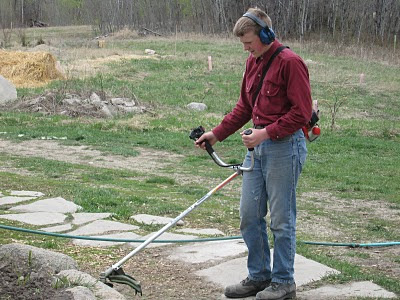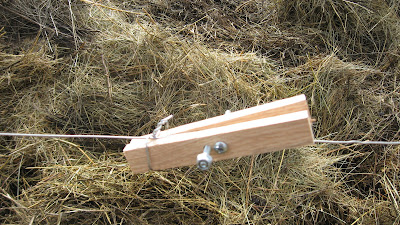
This afternoon I put in just a few of the tiles you see in the picture above. They are self sticking, vinyl, grout-line tiles from Menards. The temperature is colder than normal outside, so the temperature inside the room was below the manufaturer's recommended installation temperature. I'm looking for a little heater to put in the room just until we get the duct from downstairs installed. The walls are all done now and the floor is next on my list for that room.
I have a 31 inch stainless steel wash tank to install when the room is done that will be for all the washup after milking. Also, a couple of refrigerators to move in there, a cream separator, butter churn, lots of bottles and assorted cleaners, a cabinet, milk scale and probably a few other odds and ends as well.
I wouldn't take the time and effort to keep the milk buckets as clean as I do, if I were not that I am milking for other people.
I recently got the results from a series of tests I had done on a couple of milk samples that I sent to DQCI Services near Minneapolis, MN. I am very glad to say that the bacteria levels in our milk, are quite low. Meaning that it has an extra-long shelf life.

According to the "Raw Milk Production Handbook," the Standard Plate Count test (measures the overall bacteria levels within the milking equipment) should be less than 10,000/mL. Our milk was less than 2,500/mL.
Another test was Preliminary Incubation, or another perspective on the cleanliness of how the milk is handled. Should be less than 50,000/mL. Ours was 2000/mL.
The measure of the somatic cells in our milk was 140,000/mL. Raw milk producers like to see it below 300,000 but the commercial guys are okay at 750,000. The higher the SCC count is, the more likely it is that there is infection in the udder.
Those tests above, give me an idea of how well I have been cleaning the buckets, and how long the milk will last. I had DQCI do five tests altogether, the last two were both good and they were coliform count, and Ecoli.








 Jonathan and I have been Instructors In Training for the appleseed project for about a year now and have passed the tests for each different level of IIT. This appleseed was our 4th one that we had instructed at.
Jonathan and I have been Instructors In Training for the appleseed project for about a year now and have passed the tests for each different level of IIT. This appleseed was our 4th one that we had instructed at.


 As you see, at 100 yards the bullet hit 3 MOA high, then at 200 it was 1 MOA lower than before, at 300 it was right on and 400 it was 1.5 MOA low. With those measurements I can adjust my sights from where it was sighted in at 25 yards, up 1.5 MOA and make a hit at 400 yards without firing a shot! If I didn't adjust I would hit 6 inches low with this caliber.
As you see, at 100 yards the bullet hit 3 MOA high, then at 200 it was 1 MOA lower than before, at 300 it was right on and 400 it was 1.5 MOA low. With those measurements I can adjust my sights from where it was sighted in at 25 yards, up 1.5 MOA and make a hit at 400 yards without firing a shot! If I didn't adjust I would hit 6 inches low with this caliber.
























 Our transplants are doing really well. This year we used all our own mix of potting soil and fertilized the seedlings with manure tea. They have all done really well, except some of the cayenne peppers didn't come up at all.
Our transplants are doing really well. This year we used all our own mix of potting soil and fertilized the seedlings with manure tea. They have all done really well, except some of the cayenne peppers didn't come up at all.









 The sides are oak so they should last a while. If not, I can aways paint them before installing them on the wire.
The sides are oak so they should last a while. If not, I can aways paint them before installing them on the wire.
